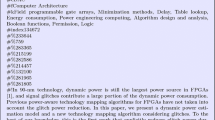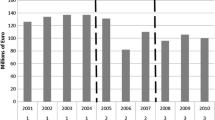Abstract
The present paper takes its place in the stream of studies that analyze the effect of interdisciplinarity on the impact of research output. Unlike previous studies, in this study the interdisciplinarity of the publications is not inferred through their citing or cited references, but rather by identifying the authors’ designated fields of research. For this we draw on the scientific classification of Italian academics, and their publications as indexed in the WoS over a 5-year period (2004–2008). We divide the publications in three subsets on the basis the nature of co-authorship: those papers coauthored with academics from different fields, which show high intensity of inter-field collaboration (“specific” collaboration, occurring in 110 pairings of fields); those papers coauthored with academics who are simply from different “non-specific” fields; and finally co-authorships within a single field. We then compare the citations of the papers and the impact factor of the publishing journals between the three subsets. The results show significant differences, generally in favor of the interdisciplinary authorships, in only one third (or slightly more) of the cases. The analysis provides the value of the median differences for each pair of publication subsets.
Similar content being viewed by others
Notes
http://www.nature.com/news/interdisciplinarity-1.18295, last accessed on 9 November 2016.
Simpson’s Index of Diversity, originally developed in biology, is defined in bibliometrics as \(1 - \sum p_{i}^{2}\), where \(p_{i} = {\raise0.7ex\hbox{${x_{i} }$} \!\mathord{\left/ {\vphantom {{x_{i} } X}}\right.\kern-0pt} \!\lower0.7ex\hbox{$X$}}\); \(X = \sum x_{i}\), and \(x_{i}\) is the number of references to the i-th subject category.
The list of all SDSs is reported in “Appendix 1” Section.
We define the “specific degree of interdisciplinarity” of a field with another specific research field as the ratio between the number of publications co-authored by researchers from both fields, to the number of publications authored by researchers belonging to the first field. The reader is referred to Abramo et al. (2012) for additional details on the methodology for identifying the SDS pairs with the highest collaboration rates.
This scaling factor results as the most effective at normalizing citations (Abramo et al. 2012).
Per publications in multi-category journals, the value of the indicator is equal to the average of the values for the individual subject categories.
References
Abramo, G., Cicero, T., & D’Angelo, C. A. (2012a). Revisiting the scaling of citations for research assessment. Journal of Informetrics, 6(4), 470–479.
Abramo, G., D’Angelo, C. A., & Di Costa, F. (2012b). Identifying interdisciplinarity through the disciplinary classification of coauthors of scientific publications. Journal of the American Society for Information Science and Technology, 63(11), 2206–2222.
Chen, S., Arsenault, C., & Larivière, V. (2015). Are top-cited papers more interdisciplinary? Journal of Informetrics, 9(4), 1034–1046.
D’Angelo, C. A., Giuffrida, C., & Abramo, G. (2011). A heuristic approach to author name disambiguation in bibliometrics databases for large scale research assessments. Journal of the American Society for Information Science and Technology, 62(2), 257–269.
Larivière, V., & Gingras, Y. (2010). On the relationship between interdisciplinary and scientific impact. Journal of the American Society for Information Science and Technology, 61(1), 126–131.
Levitt, J. M., & Thelwall, M. (2008). Is multidisciplinary research more highly cited? A macrolevel study. Journal of the American Society for Information Science and Technology, 59(12), 1973–1984.
OECD. (1972). Interdisciplinarity: Problems of teaching and research in universities. Washington, DC: OECD Publications Center.
Porter, A. L., Cohen, A. S., Roessner, J. D., & Perreault, M. (2007). Measuring researcher interdisciplinarity. Scientometrics, 72(1), 117–147.
Porter, A. L., Roessner, D. J., & Heberger, A. E. (2008). How interdisciplinary is a given body of research? Research Evaluation, 17, 273–282.
Rinia, E., Van Leeuwen, T., Van Vuren, H., & Van Raan, A. (2001). Influence of interdisciplinarity on peer-review and bibliometric evaluations in physics research. Research Policy, 30(3), 357–361.
Schummer, J. (2004). Multidisciplinarity, interdisciplinarity, and patterns of research collaboration in nanoscience and nanotechnology. Scientometrics, 59(3), 425–465.
Steele, T. W., & Stier, J. C. (2000). The impact of interdisciplinary research in the environmental sciences: A forestry case study. Journal of the American Society for Information Science and Technology, 51(5), 476–484.
Wagner, C. S., Roessner, J. D., Bobb, K., Klein, J. T., Boyack, K. W., Keyton, J., et al. (2011). Approaches to understanding and measuring interdisciplinary scientific research (IDR): A review of the literature. Journal of Informetrics, 5(1), 14–26.
Wang, J., Thijs, B., & Glänzel, W. (2015). Interdisciplinarity and impact: Distinct effects of variety, balance, and disparity. PLoS ONE. doi:10.1371/journal.pone.0127298.
Wang, J., Veugelers, R., & Stephan, P. (2016). Bias against novelty in science: A cautionary tale for users of bibliometric indicators. NBER working paper No. 22180.
Yegros-Yegros, A., Rafols, I., & D’Este, P. (2015). Does interdisciplinary research lead to higher citation impact? The different effect of proximal and distal interdisciplinarity. PLoS ONE. doi:10.1371/journal.pone.0135095.
Author information
Authors and Affiliations
Corresponding author
Appendices
Appendix 1
See Table 6.
Appendix 2
See Table 7.
Appendix 3
See Table 8.
Appendix 4
See Table 9.
Rights and permissions
About this article
Cite this article
Abramo, G., D’Angelo, C.A. & Di Costa, F. Do interdisciplinary research teams deliver higher gains to science?. Scientometrics 111, 317–336 (2017). https://doi.org/10.1007/s11192-017-2253-x
Received:
Published:
Issue Date:
DOI: https://doi.org/10.1007/s11192-017-2253-x




